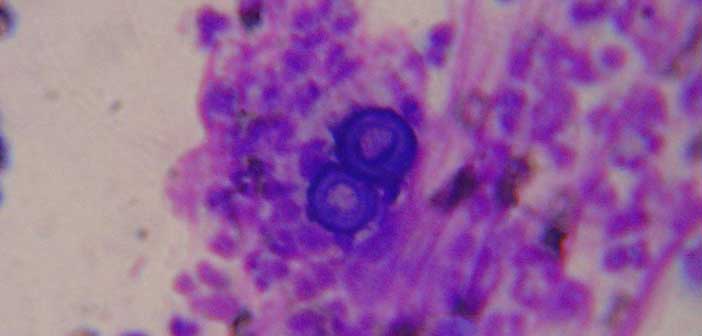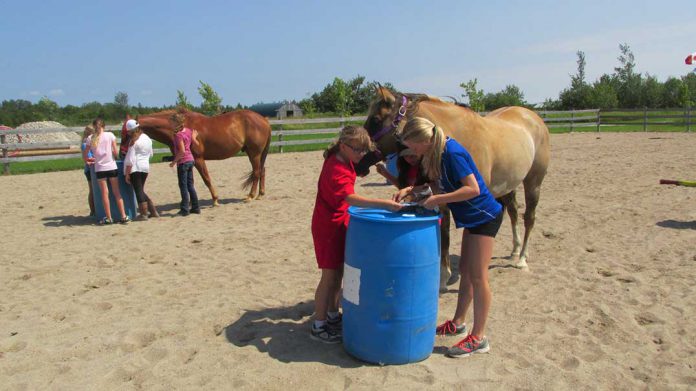MANITOULIN—Several people on Western Manitoulin Island, specifically the Sheshegwaning First Nation area, have been confirmed to have blastomycosis, a rare infection that is caused by breathing in the fungus blastomyces dermatitidis. The infection has also been confirmed to have taken the life of at least two dogs, while others are being treated for the same disease.
Holly Browne, manager of environmental health with the Sudbury and District Health Unit (SDHU), told the Recorder on Tuesday, “I can’t talk about specific cases, but what happened is that late last week (Friday) we were advised that a group of young people had been taken to the hospital due to possible blastomycosis. They were then transferred from hospital on Manitoulin Island to the Health Sciences North in Sudbury.”
“Three of the children were confirmed as being infected with blastomycosis,” said Ms. Browne. “The fourth child, although not confirmed with having the infection, but due to their link with the other people (in the same community), was advised to go ahead and get treatment. As well, we (SDHU) released an advisory note to local physicians to recognize this cluster of three persons being confirmed and provided information on how to test and treat blastomycosis.”
“It is blastomycosis,” a Sheshegwaning resident told the Recorder on Tuesday. “One of our dogs passed away Saturday-it was too far gone and the blastomycosis infection had taken it over.” She noted the young dog’s sister has undergone treatment “and we’ve been told she has an 85 percent chance of survival.”
The woman told the Recorder, “one of my children, my daughter, has a bad cough, but seems to be fine since she got medication for it (blastomycosis). Our doctor said if she shows any more systems to bring her back to the hospital.” She pointed out one dog in Silver Water was also confirmed as having blastomycosis.
She continued, “at this point no one has any idea where the blastomycosis came from. This is obviously a very scary thing, and people need to know it is out there for identification purposes and as to what they can do if someone gets the symptoms.” She noted that in the case of the young dog, “it came on in a couple of weeks. Our dog wasn’t eating and had a lot of trouble walking. People need to know blastomycosis is out there.”
Derek Graham, chief executive officer of the Manitoulin Health Centre (MHC), told the Recorder on Tuesday, “we have had a couple of patients with suspected cases (of blastomycosis) at our Mindemoya site and they have been referred on to HSN (Health Sciences North). From my understanding the cases were identified as blastomycosis.” He pointed out the MHC has shared this information internally to hospital staff at both Island hospital sites and MHC partners including the SDHU to be on the lookout for patients with similar symptoms as blastomycosis.
Ms. Browne further explained, “our counterparts at Health Canada are working with the community (Sheshegwaning) and leaders with on-site investigation and are going to hold community meetings and provide information on blastomycosis, its symptoms and what people should do if they have its symptoms and to prevent it.”
“One of the biggest things we are telling people that if they have symptoms of blasto, to see their doctor and push for testing to done for blasto,” said Ms. Browne. “We are working with Health Canada on all of this, consulting back and forth,” noting that similar community consultations on blastomycosis have taken place in other Island communities in the past two years, Little Current (hosted by The Manitoulin Expositor), Birch Island and Sheguiandah.
“We can only do education, awareness and steps to prevent it,”said Ms. Browne. But she said finding the area where the fungus that causes blastomycosis is prevalent is not possible. “Environmental sampling has proven in the past to be unsuccessful in finding it. It is very difficult to find. But we know blasto is around (the SDHU area) and is considered an endemic area for the fungus that causes blastomycosis and has been here for a long time. And because of this we undertake education and awareness programs annually.”
Ms. Browne stressed again, “the biggest thing is that if anyone has symptoms of blastomycosis to tell their doctor and be tested for it.” She said the tests are quick, and once on medication the medication has proven to be successful.
Blastomycosis is not contagious from person to person, or from animal to person. She pointed out that 50 percent of people who are exposed to blastomycosis don’t develop the infection. “That’s why having a cluster of people in one area getting the infection is disturbing.”
The SDHU, in a release on Thursday, June 29, 2017 entitled “Blastomycosis-What you need to know to protect yourself” stated, “the Sudbury and District Health Unit service area is considered an endemic area for the fungus that
causes blastomycosis (www.sdhu.com/health-topics-programs/diseases-infections/blastomycosis).
Activities that disturb damp soil or rotting wood, such as digging or raking, may release the blasto-causing fungus into the air. The fungus is found in moist acidic soil in parts of Northern Ontario, Manitoba, Saskatchewan, Quebec as well as other areas around the Great Lakes and Mississippi Valley.
Although this is a rare infection, it is important to know how to reduce exposure to the fungus when working in moist soil area, such as under the house, cottage, porch or shed. Simple precautions include wearing work gloves, proper footwear, long pants, long-sleeved shirts, and a disposable NIOSH N100 approved HEPA filter dust mask.
The symptoms of blastomycosis can be similar to those of influenza or pneumonia. “If you have a persistent cough, muscle aches, joint pain, tiredness, chills, low-grade fever, skin sores or unexplained weight loss, let your health care provider know that you may have been exposed to the fungus that causes blastomycosis,” said Rylan Yade, an environmental support officer at the SDHU. “They will want to know if you have been in a high-risk area and in contact with moist soil.” People typically become sick between 21 and 100 days after being exposed to the fungus. If the infection is left untreated, blastomycosis may be fatal.”
For more information on call the Sudbury and District Health Unit at 705-522-9200, ext. 398, toll-free 1-866-522-9200, or visit www.sdhu.com.





